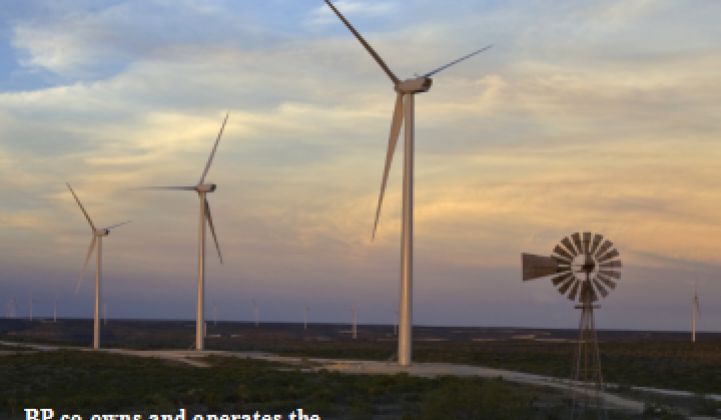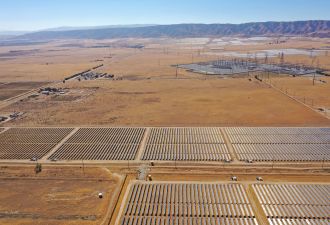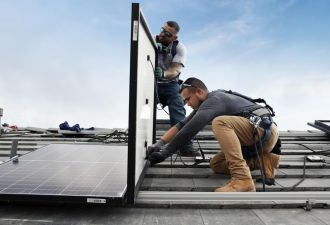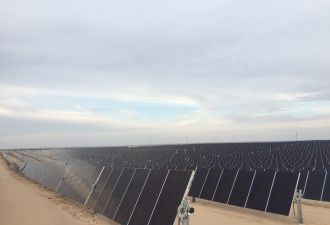It would be understandable if John Graham, BP Wind Energy’s President and CEO, was discouraged by the wind industry slowdown and the fate of the firm's parent company in the Gulf of Mexico. Instead, he seems quietly determined.
“We’re following our policy,” Graham said. “We invest about $300 million a year. We’ve done it consistently and will continue to do so. We continue to build and operate.”
Graham appeared to be steadfast. “There are business cycles that you go through; we’re happy to ride those cycles through.”
He acknowledged the parent company’s Gulf of Mexico tragedy and the loss of eleven lives, but insisted it has had no impact on BP Wind Energy’s strategy.
“All of the businesses we deal with in terms of daily ongoing transactions have been extremely sensitive and supportive of us,” Graham said. Because they recognize that BP is financially secure, “we haven’t had any impacts of being able to do business,” he said.
BP Wind Energy has 1,205 megawatts of installed capacity in seven states, two new projects near completion in Idaho and Colorado, and two more in advanced stages of development. “Our business has been around since 2006 as part of BP’s push into the alternative energy space,” Graham said. “Over the last couple of years, we have invested in excess of three billion dollars of cash into physical assets of nine operating wind farms and two in construction.”
Shortly after BP entered the wind business, the company made the strategic decision to focus its resources in U.S. onshore wind. “That was a decision made back in 2007,” Graham said, “that our greatest opportunity to build out a wind business was in the U.S. market.”
Though U.S. policy development now seems stuck and U.K. offshore wind is advancing, Graham didn’t see any reason to reverse the decision. “I think the U.S. is becoming more aware of the potential of offshore wind,” he said, “but only time will tell if people invest in putting steel in the sea.”
BP Wind Energy is, nevertheless, encountering the same challenges as other wind developers “at the state level and the federal level,” Graham said. Of the state issues, “probably the biggest one right now is from the Department of Defense radar concerns.”
The radar profile of a modern wind turbine reads similarly to an airplane, creating national security complications. The American Wind Energy Association (AWEA) and developers are working on solutions. Graham expressed concern that the solutions would both protect national security and wind development.
There are, however, technological fixes. “I’m not an expert on this,” Graham said, “I think it ultimately comes down to what it is in the old radar technology that can be improved with more modern radar technology.” Graham expects a solution to be devised soon. “It isn’t a big financial issue,” he said. “It’s just a willingness to do it. And I think that’s what the industry is trying to work with.”
Graham’s insight into the transmission challenge was valuable. “The challenge is how you get the wind resources in the center of the states out to the population that needs the power,” he said. “The regional nature of the transmission network which has been in place for a hundred years -- state-based, really -- hasn’t kept up.”
Graham didn’t see a national high-voltage transmission superhighway, the obvious solution, as achievable. “Unfortunately, you then start crossing the old state and the old regional transmission companies and there really isn’t a strong mechanism which can allow them to work together,” he said. “And the question is, who’s going to pay for that? How’s it going to get built? And how does it get sited? Who’s got the authority?”
But he said a compromise is emerging. “I’m seeing more of regional pressure for local states to combine with each other to create a transmission pool,” Graham said. “It probably makes more sense to have regional solutions.”
BP Wind Energy, Graham said, is committed to environmentally sensitive wind-farm siting. “Dealing with wildlife issues is something we always have to take good care of,” Graham said. “We’re working with lots of bodies to help develop what is the best policy and good practice. It's not an obstacle, but something that, as a business, we have to deal with.”
On the federal level, Graham focused on two matters with one theme. “The tax incentives and grants,” he said, “are very important as the industry develops to keep the price of wind competitive.”
But the tax benefits and grants made available in the 2008 financial rescue legislation and the 2009 Recovery Act have not been extended by Congress. “It’s the uncertainty about whether those incentives will continue that causes the cycles of the wind industry,” Graham said.
The second federal matter, Graham said, is the national Renewable Electricity Standard (RES). “But the politicians haven’t been able to get an energy bill in place,” Graham said. That impedes wind development, and “This uncertainty of demand being generated certainly puts all that investment and jobs at risk.”
An RES recently re-introduced in the Senate would require U.S. utilities to obtain 15% of their power from renewable sources by 2021. Some consider it too compromised. “Many in the industry would like a bigger number,” Graham said, but “once a proposal is passed, it can be improved over time.”



